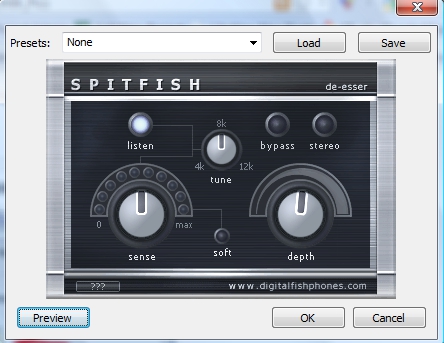De-Essing Files
From Librivox wiki
This page will introduce how to use the Spitfish add-on to decrease the ess sounds in a file. If you find your file to be really essy (with strong S sounds), you can try using this tool.
Download & Install the Spitfish Add-on
The latest version of Fish Fillets (which contains Spitfish) can be found here.
To install:
- Unzip the Zip file.
- Copy the SPITFISH.dll file into your 'Plug-Ins' folder, located in the Program Files > Audacity folder. (Mac OS X users: place the files in the directory '~/Library/Audio/Plug-Ins/VST/')
- Start Audacity.
Using Spitfish
- Open the Audacity file you want to de-ess.
- Select the entire track (or just a portion, if you want to de-ess only a portion of the file).
- Go to Effects > digitalfishphones: SPITFISH
- Click on the "listen" button. This will make it so you only hear the S sounds you want to remove.
- Move the "Sense" and "Depth" knobs to about 50%, then click Preview. Adjust the knobs as desired until you only hear S sounds and no others.
- The "sense" knob seems to control what is removed, and the "depth" knob seems to control how much of it is removed.
- When satisfied with the levels, click the "listen" button again to turn it off, and click Preview to listen to the preview of the de-essed track.
- If you like what you hear, click on OK. If not, go back into "listen" mode and continue to play with the levels until you're satisfied, THEN click OK.
That's it! Take a listen to the modified track. If you don't like it, you can do a Control-Z (or Edit/Undo) to restore the track to how it was before.
It may take some practice to figure out the best levels of "sense" and "depth" for your particular track.
